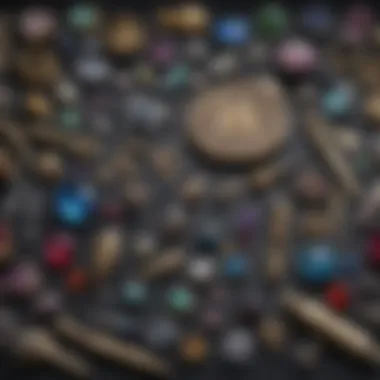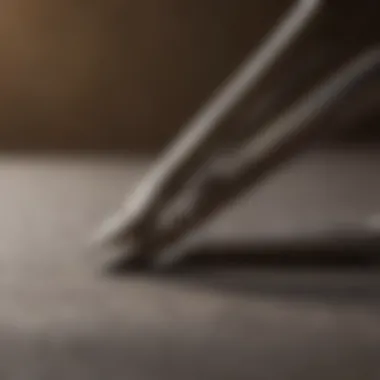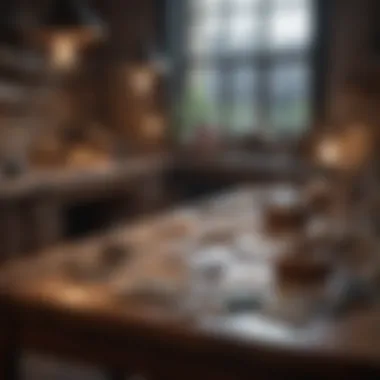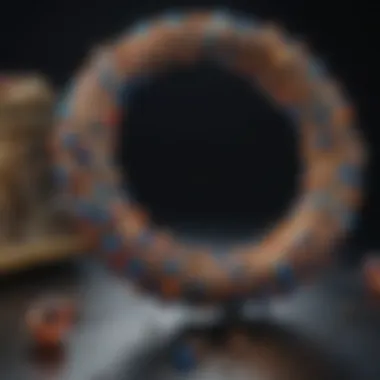Essential Jewelry Making Tools for Beginners & Pros


Intro
Jewelry making is both an art and a science. For anyone looking to dive into this craft, having the right tools is imperative. Not only do these tools help create beautiful pieces of jewelry, but they also contribute to the overall effectiveness and precision of the craft. In this article, we will explore essential jewelry making tools that cater to both beginners and enthusiastic hobbyists.
Understanding the significance of each tool can significantly enhance the crafting experience. Tools serve distinct purposes, preparing you to create stunning designs with ease. Whether you are working with beads, metals, or gems, being familiar with your tools will foster confidence and skill in your endeavors.
By the end of this article, you'll gain valuable insights into assembling your toolkit, thus empowering your creative journey in jewelry making.
Understanding Jewelry Making Tools
Jewelry making is both an intricate art and a technical craft. Understanding jewelry making tools is fundamental for anyone embarking on this journey, whether one is a beginner or a seasoned enthusiast. The right tools not only enhance creativity but also ensure precision in crafting pieces. This section unpacks the crucial aspects of using quality tools and provides an overview of the basic tools necessary in jewelry making.
Importance of Quality Tools
When diving into the world of jewelry making, the importance of quality tools cannot be overstated. High-quality tools can drastically improve the crafting experience and the final outcome of each piece. Poor quality tools may lead to mistakes or imperfect finishes, creating frustration among makers.
Investing in good tools ultimately pays off, as it streamlines the crafting process and produces better results. Furthermore, using inadequate tools can cause injury or accidents, underscoring the necessity for reliable equipment. Quality tools often bring longevity and are designed for specific tasks, making them easier and safer to use.
Overview of Basic Tools
Getting started in jewelry making requires familiarization with essential tools. Having a solid understanding of these basic tools enables better preparation for any project. Here’s an overview of key items:
- Pliers: Various types of pliers are indispensable for bending and cutting wire.
- Wire Cutters: Efficient for creating clean cuts in wire, ensuring neat joints.
- Tweezers: Useful for handling small components without damaging them.
- Calipers: Necessary for accurate measurement of thickness and length.
- Jewelry Saw: Essential for cutting different materials precisely.
- Files: Help refine and smooth edges, contributing to the finishing touch.
These tools form the foundation of any jewelry making toolkit. Understanding their roles and functions will significantly enhance one's ability to create intricate and beautiful pieces. As one grows in skills and experience, additional specialized tools can be incorporated to expand capabilities, but the basics always remain vital.
Investing in quality tools provides greater safety and accuracy, making your jewelry creations not just artistic expressions, but also crafted with care.
Essential Hand Tools
In jewelry making, hand tools play a crucial role. They are not just instruments but extensions of an artisan's skill. Having the right hand tools allows for precision, efficiency, and creativity in every project. From shaping and cutting to assembling components, these tools enable the crafting of intricate and beautiful designs. As beginners and enthusiasts delve into jewelry making, understanding the various hand tools becomes essential for enhancing their crafting experience.
Pliers: Types and Uses
Pliers are fundamental hand tools in the world of jewelry making. Each type serves a specific purpose and contributes to the overall quality of a piece. Understanding the different types of pliers is vital for beginners and seasoned makers alike.
Chain Nose Pliers
Chain nose pliers are characterized by their long, tapered jaws and flat inner surfaces. Their design allows for precise manipulation of small components, making them ideal for gripping and bending wire. The main characteristic that sets them apart is their ability to reach into tight spaces. This makes them a beneficial choice for threading beads, opening jump rings, and shaping wire.
A unique feature of chain nose pliers is their smooth inner surface, which prevents damage to delicate components. However, one disadvantage is that they may not provide enough grip for very thick wires or larger components.
Round Nose Pliers
Round nose pliers have rounded jaws that taper to a point. They are specifically designed for creating loops and curves in wire, essential for making components such as jump rings and eye pins. This tool is popular among jewelry makers due to its versatility; it allows for smooth, rounded bends without kinking the wire.
The unique feature of round nose pliers is their ability to make uniform loops of various sizes, which is crucial for consistency in projects. However, they may not be as effective when working with very thin or very thick wires, where precision might be lost.
Flat Nose Pliers
Flat nose pliers have flat, wide jaws that provide a strong grip on materials. They are commonly used for holding and bending, facilitating the flattening of wire or metal components. Their key characteristic is the flat inner surface, allowing for effective gripping without marring the material.


Flat nose pliers are beneficial when creating sharp bends or holding pieces firmly in place. The downside is they may not be suitable for tasks requiring precision in tight spaces, where their bulkiness could hinder detailed work.
Wire Cutters
Wire cutters are vital tools for cutting through various gauges of wire. They simplify the process of shortening wires and trimming ends, which is essential for any jewelry project. A high-quality pair of cutters ensures clean cuts, preventing frays that can lead to weak links in jewelry. Choosing wire cutters suited for the specific thickness of wire used is important for achieving desired outcomes.
Tweezers
Tweezers are understated but essential tools for jewelry makers. They assist in handling small components without risking damage. A good pair of tweezers allows for precise placement of tiny beads, gemstones, or findings. Their design provides the required control. Additionally, precision tweezers can be useful for picking up and placing items without smudging or damaging, enhancing the overall quality of the final piece.
In summary, hand tools are not merely accessories but foundational elements in jewelry making. Understanding their unique functions and how to use them properly can make a significant difference in the quality of your work. Engaging with each tool provides opportunities for learning, creativity, and mastery in the craft of jewelry making.
Measurement and Marking Tools
In the realm of jewelry making, precision is not merely a goal; it is a necessity. Measurement and marking tools stand as the foundation for any successful project, whether one is crafting intricate designs or simple pieces. These tools help ensure that components fit together perfectly and that proportions are just as intended. This section delves into the significance of accurate measurement and marking in jewelry making, focusing on some essential tools that facilitate these tasks.
Calipers
Calipers are indispensable for jewelers who require precise measurements. They provide the ability to measure internal, external, and depth dimensions with great accuracy. Jewelers often use digital calipers for their ease of reading and high precision. They are ideal for measuring gemstones, metal thickness, and gaps in designs. When selecting a caliper, it's advisable to choose one with a range suitable for your projects.
Rulers and Measuring Tapes
Rulers and measuring tapes are straightforward yet essential tools in jewelry making. A good ruler allows jewelers to perform measurements in both imperial and metric units, which is particularly useful when dealing with various materials from different regions. Measuring tapes are particularly effective for larger materials or when flexibility is required.
When working with wire or chain, consider a ruler with clear markings and a sturdy grip to ensure stability during measurement. Investing in a flexible metal ruler can also be beneficial, as it can bend around curves and irregular shapes, enhancing accuracy further.
Markers and Scribes
Markers and scribes are critical for transferring measurements to materials. A good marking system ensures that cuts are made precisely where needed, reducing waste and improving the overall finish of the piece.
Markers are typically used for materials like wood or softer metals. They must have a fine tip for detailed work. On the other hand, scribes are preferable for harder surfaces, as they create visible lines that are easy to follow with cutting tools. Using non-permanent ink markers will help in making adjustments without leaving permanent marks.
Effective measuring and marking are the cornerstones of successful jewelry making. With the right tools, you can enhance the precision of your work, resulting in higher quality pieces and greater satisfaction in the creation process.
Cutting and Shaping Tools
Cutting and shaping tools are vital for any jewelry maker, whether a beginner or an advanced artisan. These tools allow crafters to manipulate raw materials into desired shapes and sizes, which are crucial steps in the jewelry-making process. Their precision directly affects the quality and appearance of the final product.
Using the appropriate cutting and shaping tools can enhance overall efficiency and ensure that designs flow seamlessly from concept to reality. While they may seem simple, the intricacies involved in choosing and using these tools can significantly impact the final result.
Jewelry Saw
The jewelry saw is one of the most fundamental cutting tools used in jewelry making. It consists of a thin, flexible blade mounted in a frame, allowing artisans to create intricate cuts with ease. The saw is particularly valuable for cutting metal sheets, providing clean and precise edges that are crucial for fitting components together properly.
Different types of blades are available, each suited for various materials and thicknesses. Choosing the correct blade type is essential for achieving desirable results. Additionally, learning to operate the jewelry saw correctly involves mindful technique. This ensures not only accuracy but reduces the risk of damaging the material being used.
File Types and Functions
Files play a critical role in the finishing touches of jewelry pieces. Various file types exist, including flat files, half-round files, and round files, each serving distinct purposes.
- Flat Files: Best for smoothing flat surfaces and making even edges.
- Half-Round Files: Ideal for working on both flat and curved surfaces, making them versatile.
- Round Files: Perfect for intricate detailing and shaping inside curves.


Selecting the right file type helps improve the appearance of the jewelry while also easing the assembly process. Understanding the function of each file type is essential for effective crafting.
The Role of Mandrels
Mandrels are tools used to shape and form jewelry items, particularly rings and bracelets. They come in various diameters, allowing artisans to create items that fit perfectly. Working with mandrels provides control over the shaping process, enabling users to achieve consistent shapes.
When using a mandrel, it's important to be mindful of the material being shaped, as different materials respond uniquely to pressure. The correct application of force will ensure that no damage occurs to the piece being created. Mandrels can significantly elevate the expertise of a jeweler, offering precision in crafting and a refined finish in the final product.
Assembly and Finishing Tools
Assembly and finishing tools play a crucial role in the jewelry making process. These tools are essential for completing a project, ensuring that every element is securely attached and finished to the highest standards. Without proper assembly, even the finest materials can end up looking unprofessional. Finishing tools help in providing the final touches that elevate the overall appearance of the jewelry piece. This section will explore the essential types of assembly and finishing tools used in jewelry making, their significance, and factors to consider when selecting these tools.
Soldering Equipment
Soldering Iron
The soldering iron is a vital tool for anyone interested in creating jewelry with metal components. Its main purpose is to join metal pieces together using solder. A high-quality soldering iron can reach and maintain the temperatures necessary for effective soldering.
One key characteristic of the soldering iron is its wattage. Typically, a soldering iron rated between 30 to 60 watts is sufficient for most jewelry tasks. This range allows for sufficient heat without posing too much risk to delicate materials. A soldering iron also usually comes with interchangeable tips, enabling users to choose the appropriate size and shape for various applications.
A significant advantage of using a soldering iron is its ability to work with different types of solder, including lead-free options, which are safer for both the user and the environment. However, beginners should be cautious since improper use can result in overheating or damaging the pieces being worked on.
Solder
Solder is an alloy used to join metal pieces together, and it comes in various formulations. The most common types of solder used in jewelry making are silver solder and gold solder, both designed to melt at different temperatures. Silver solder is notably popular due to its lower melting point compared to gold solder, making it easier for new jewelers to use effectively.
One of the key characteristics of solder is its flow. Good solder will flow easily into the joints of your metal, creating a strong bond once cooled. This flow is often enhanced by using flux, a chemical that prevents oxidation and helps the solder to adhere better. A unique feature of solder is that it can be designed for different melting points, enabling artisans to choose the right kind for the specific metals they are working with.
Despite its benefits, some disadvantages exist. Solder joints can sometimes be less strong than the original metal, meaning that careful technique is necessary to avoid issues in the finished piece.
Buffing and Polishing Tools
Buffing and polishing tools are essential for giving jewelry a professional finish. They remove scratches, restore shine, and enhance the overall appearance of the metal. These tools come in various forms, from handheld options to more complex machinery depending on the scale of production.
Using buffing wheels with different grades of abrasive compounds can help achieve a smooth surface. It's important to select the right type of wheel for the material; for example, a fabric buff wheel is often effective for softer metals, while harder metals may require a broader buffing wheel.
Keep in mind that safety should always be a priority when using these tools. Using appropriate protective equipment is necessary to avoid any injuries during the buffing or polishing processes.
The correct use of assembly and finishing tools greatly influences the quality and durability of a jewelry piece. By investing time and effort into selecting the right tools, jewelers can ensure their creations meet both aesthetic and functional standards.
Safety Equipment
In jewelry making, safety equipment is paramount. Engaging with tools and materials without proper safety measures can lead to injuries or long-term health issues. Understanding the basics of safety equips both novices and experienced artisans to work efficiently while minimizing risks. Investing in safety gear such as protective eyewear and gloves not only protects the individual but enhances overall creativity and productivity in crafting.
Protective Gear
Safety Glasses
Safety glasses are a crucial component of protective gear in jewelry making. When cutting, soldering, or handling small pieces, protecting the eyes from flying debris is vital. The key characteristic of safety glasses is their robust design, often made from impact-resistant materials. This makes them a beneficial choice for anyone involved in hands-on jewelry crafting.
A unique feature of safety glasses is their ability to fit over prescription eyewear, allowing for versatility for jewelers with vision needs. While they can be slightly more expensive than regular glasses, their value in preventing eye injuries far outweighs the cost. Proper ventilation often goes along with their use as fumes from soldering can be harmful, making the glasses even more important.


Gloves
Gloves are another essential piece of safety equipment. They provide protection against sharp edges and hot surfaces when using tools. The key characteristic of gloves in jewelry making is their ability to offer a good grip while maintaining the dexterity needed for precise work. Many jewelers prefer gloves made from materials like nitrile or leather, which are both strong and flexible.
A unique feature of high-quality gloves is their resistance to chemicals found in jewelry-making processes. However, it's worth noting that not all gloves provide the same level of feel, which might be a disadvantage for intricate tasks. In any case, using gloves can significantly reduce the risk of cuts and burns.
Ventilation and Work Area Setup
Setting up an appropriate work area is crucial for maintaining safety during jewelry making. Proper ventilation is necessary, especially when using chemicals or soldering equipment. A well-ventilated space minimizes exposure to harmful fumes and ensures a healthier crafting environment.
Additionally, ensuring that tools are arranged neatly can prevent accidents. Keeping equipment organized allows for quick access without the risk of knocking something over. When you take the time to create a safe workspace, you greatly improve both your comfort and ability to focus.
"Safety is not just about wearing protective gear; it's about creating an environment that fosters creativity without harmful interruptions."
By addressing safety with seriousness and diligence, you can enjoy jewelry making with a clear mind, focusing entirely on your artistic expression.
Maintaining Your Tools
Maintaining your tools is critical for anyone serious about jewelry making, be it a beginner or an experienced artisan. Tools are the backbone of any craft. Without proper care, their efficiency degrades and can severely affect the quality of your work. Clean and well-maintained tools not only provide better performance but also prolong their lifespan. Ignoring maintenance can lead to tools becoming damaged, which may result in costly replacements or repairs.
Cleaning Techniques
Cleaning your jewelry making tools should be a regular part of your routine. Different materials require specific cleaning methods. For example, metal tools like pliers or wire cutters collect grime and tarnish. A simple solution to clean these is to use a soft cloth with mild soap and water.
- Soap and Water: It is effective for general cleaning. Just ensure to dry them thoroughly afterward to avoid rusting.
- Isopropyl Alcohol: Good for disinfecting your tools, especially if they are used for handling beads or other materials.
- Brushes: Small brushes can get into the nooks and crannies of intricate tools. A toothbrush can work nicely for this purpose.
In addition to cleaning, check regularly for rust or damage. Minor issues can be addressed before they become more significant problems.
Storage Solutions
Proper storage is equally important to maintain the integrity of your tools. Good storage solutions can prevent wear and tear, and in some cases, loss of equipment. Here are some storage methods to consider:
- Toolboxes: A toolbox is an essential investment. Choose one that is padded and organized to prevent tools from knocking against each other.
- Magnetic Strips: Useful for hanging pliers and cutters. They keep tools accessible and reduce the risk of accidents.
- Drawer Organizers: If you prefer drawers, use dividers to separate tools. This prevents any clutter, making it easier to find what you need.
"Keeping your workspace and tools organized not only enhances productivity but also creates a more enjoyable crafting experience."
Closure and Next Steps
As you complete your exploration of essential jewelry making tools, it is important to contemplate the next steps in your journey. Understanding the significance of these tools lays a strong foundation for both beginner and enthusiast alike. This final section encapsulates the importance of investing in quality tools and the continuous pursuit of knowledge in this intricate craft.
Investing in Quality Tools
The investment in quality jewelry making tools cannot be overstated. High-quality tools enhance the overall experience of crafting by providing better functionality and durability. For instance, when using precise tools like calipers or pliers, the difference in quality can affect not only the ease of shaping materials but also the final look of your pieces.
Choosing tools from reputable brands ensures that they meet safety standards and perform effectively. A well-made soldering iron or a reliable set of wire cutters will hold up to frequent use, saving you money in the long term since they will not need replacing as often as cheaper alternatives.
When selecting tools, consider these factors:
- Material Quality: Sturdy materials resist wear and tear, ensuring longevity.
- Functionality: Tools that serve multiple purposes can save space and money.
- Comfort: Ergonomically designed handles can reduce strain during prolonged use.
Taking time to research and select the right tools fosters a better crafting environment and can improve results.
Continuing Education in Jewelry Making
The world of jewelry making is ever-evolving, and staying informed is key. Engaging in ongoing education helps crafters keep abreast of new techniques, tools, and trends. Options for continuing education include workshops, online courses, and tutorials. These platforms offer insights from experienced artisans and expose crafters to diverse techniques.
Participating in classes provides a framework for skill development and can enhance creativity. Joining forums or social media groups dedicated to jewelry making can also be beneficial. These spaces allow artisans to exchange ideas, share struggles, and find inspiration.
In summary, as you reflect on your journey through the essential tools for jewelry making, remember that investment and education are crucial. The right tools paired with continuous learning will elevate your crafting abilities, ultimately leading to greater satisfaction and artistic expression in your creations.
"Investing in tools is investing in your craftsmanship. Continuous learning is investing in your art."



